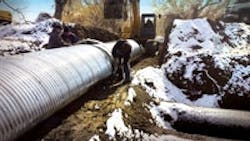Siphoning Flow
About the author: Bob Kerr is director of product management – plastics for Contech. Kerr can be reached at [email protected].
In the spring of 2014, Park County, Wyo., decided to reconstruct an irrigation siphon that ran beneath Bear Creek and flowed along the intersections of Wilson-McKissack near Cody, Wyo. The siphon and diversion structure at the intersection of Bear Creek was intended to channel high flow and prevent the likelihood of ponding and migration around the culvert for improved hydraulics against the threat of unusual storm water runoff in the surrounding area caused by floodwaters.
According to the U.S. Bureau of Reclamation, Col. William F. “Buffalo Bill” Cody made this area famous in the early days of the West. Buffalo Bill and his companions were the first to perceive the possibilities of turning the sagebrush flats of Wyoming’s Bighorn Basin into a land of agricultural abundance through irrigation. In 1899, they acquired from the state of Wyoming a right to appropriate waters from the Shoshone River for the irrigation of about 60,000 acres of public domain near Cody. As an initial step, they constructed a canal on the south side of the Shoshone River. In 1903, the Wyoming State Board of Land Commissioners, with Cody’s approval, urged the Reclamation Service to complete the proposed irrigation development.
After considering several options, the county selected a solution provided by Contech Engineered Solutions in which DuroMaxx steel-reinforced polyethylene would be used for the dual-barreled siphon due to its watertight joint capabilities, ease of installation and overall lower cost. The original creek culvert installed underneath the irrigation ditch was undersized and had failed over time due to improper construction methods, becoming pinched beneath the weight of the irrigation channel.
The 80 ln ft of 54-in.-diameter galvanized, HEL-COR pipe arch would be used for the creek crossing, while buried directly beneath would be the double-barreled run of 160 ln ft of 42-in.-diameter DuroMaxx steel-reinforced polyethylene for the irrigation siphon. The steel-reinforced profile of the pipe would provide all the strength of steel while the polyethylene would provide the necessary durability.
Site Constraints
One of the main challenges of the installation was the extremely tight site constraints. The geometry of intersection of the creek and the irrigation canal alignments underneath the county road were similar in elevation, making the project challenging; however, both the corrugated arch pipe and the twin barrels of irrigation siphon were installed with relative ease given these constraints.
Park County was happy that not only was it able to purchase both products from one supplier, but that Contech provided the technical information needed for this unique installation of a siphon under a creek crossing.
With some slight weather delays and the setting of the concrete surrounding the culvert, the installation took about five weeks. The county road and bridge crews were able to install both the siphon pipe and creek arch culvert smoothly. The final result was a much more functional storm sewer system, constructed on schedule and within a tight budget.
Eliminating Hazards
The Wyoming Game and Fish Department has classified the nearby South Fork Shoshone River basin as a crucial aquatic habitat priority area because it supports a productive sport fishery and has a core conservation population of Yellowstone cutthroat trout. The installation of this storm sewer system will help to eliminate fish entrainment—a hazard to all fish species that migrate to and from the Buffalo Bill Reservoir.
“The Contech sales engineer was easy to work with and showed interest in the installation and outcome of the project,” said Jeremy R. Quist, Park County staff engineer. “Materials were of good quality and were easy for the county road and bridge crews to install. Overall, we were
completely satisfied.”
Download: Here
